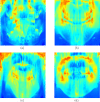DENSEN: a convolutional neural network for estimating chronological ages from panoramic radiographs
- PMID: 36241969
- PMCID: PMC9569056
- DOI: 10.1186/s12859-022-04935-0
DENSEN: a convolutional neural network for estimating chronological ages from panoramic radiographs
Erratum in
-
Correction: DENSEN: a convolutional neural network for estimating chronological ages from panoramic radiographs.BMC Bioinformatics. 2022 Dec 22;23(1):557. doi: 10.1186/s12859-022-05115-w. BMC Bioinformatics. 2022. PMID: 36550409 Free PMC article. No abstract available.
Abstract
Background: Age estimation from panoramic radiographs is a fundamental task in forensic sciences. Previous age assessment studies mainly focused on juvenile rather than elderly populations (> 25 years old). Most proposed studies were statistical or scoring-based, requiring wet-lab experiments and professional skills, and suffering from low reliability.
Result: Based on Soft Stagewise Regression Network (SSR-Net), we developed DENSEN to estimate the chronological age for both juvenile and older adults, based on their orthopantomograms (OPTs, also known as orthopantomographs, pantomograms, or panoramic radiographs). We collected 1903 clinical panoramic radiographs of individuals between 3 and 85 years old to train and validate the model. We evaluated the model by the mean absolute error (MAE) between the estimated age and ground truth. For different age groups, 3-11 (children), 12-18 (teens), 19-25 (young adults), and 25+ (adults), DENSEN produced MAEs as 0.6885, 0.7615, 1.3502, and 2.8770, respectively. Our results imply that the model works in situations where genders are unknown. Moreover, DENSEN has lower errors for the adult group (> 25 years) than other methods. The proposed model is memory compact, consuming about 1.0 MB of memory overhead.
Conclusions: We introduced a novel deep learning approach DENSEN to estimate a subject's age from a panoramic radiograph for the first time. Our approach required less laboratory work compared with existing methods. The package we developed is an open-source tool and applies to all different age groups.
Keywords: Chronological age estimation; Forensic anthropology; Orthopantomogram; Soft Stagewise Regression Network.
© 2022. The Author(s).
Conflict of interest statement
The authors declare that they have no competing interests.
Figures







Similar articles
-
Automatic and robust estimation of sex and chronological age from panoramic radiographs using a multi-task deep learning network: a study on a South Korean population.Int J Legal Med. 2024 Jul;138(4):1741-1757. doi: 10.1007/s00414-024-03204-4. Epub 2024 Mar 12. Int J Legal Med. 2024. PMID: 38467754 Free PMC article.
-
Deep learning for forensic age estimation using orthopantomograms in children, adolescents, and young adults.Eur Radiol. 2025 Jul;35(7):4191-4202. doi: 10.1007/s00330-025-11373-y. Epub 2025 Jan 25. Eur Radiol. 2025. PMID: 39862249 Free PMC article.
-
Accuracy of automated forensic dental age estimation lab (F-DentEst Lab) on large Malaysian dataset.Forensic Sci Int. 2024 Aug;361:112150. doi: 10.1016/j.forsciint.2024.112150. Epub 2024 Jul 15. Forensic Sci Int. 2024. PMID: 39047517
-
Dental age estimation: A comparative study of convolutional neural network and Demirjian's method.J Forensic Leg Med. 2024 Apr;103:102679. doi: 10.1016/j.jflm.2024.102679. Epub 2024 Mar 21. J Forensic Leg Med. 2024. PMID: 38537363
-
Correction: DENSEN: a convolutional neural network for estimating chronological ages from panoramic radiographs.BMC Bioinformatics. 2022 Dec 22;23(1):557. doi: 10.1186/s12859-022-05115-w. BMC Bioinformatics. 2022. PMID: 36550409 Free PMC article. No abstract available.
Cited by
-
Estimating chronological age through learning local and global features of panoramic radiographs in the Korean population.Sci Rep. 2023 Dec 9;13(1):21857. doi: 10.1038/s41598-023-48960-2. Sci Rep. 2023. PMID: 38071386 Free PMC article.
-
Performance of Artificial Intelligence Models Designed for Automated Estimation of Age Using Dento-Maxillofacial Radiographs-A Systematic Review.Diagnostics (Basel). 2024 May 22;14(11):1079. doi: 10.3390/diagnostics14111079. Diagnostics (Basel). 2024. PMID: 38893606 Free PMC article. Review.
-
The impact of multi-modality fusion and deep learning on adult age estimation based on bone mineral density.Int J Legal Med. 2025 Jul;139(4):1721-1733. doi: 10.1007/s00414-025-03432-2. Epub 2025 Mar 18. Int J Legal Med. 2025. PMID: 40100354
-
A population-based study to assess two convolutional neural networks for dental age estimation.BMC Oral Health. 2023 Feb 17;23(1):109. doi: 10.1186/s12903-023-02817-2. BMC Oral Health. 2023. PMID: 36803132 Free PMC article.
-
Panoramic imaging errors in machine learning model development: a systematic review.Dentomaxillofac Radiol. 2024 Mar 25;53(3):165-172. doi: 10.1093/dmfr/twae002. Dentomaxillofac Radiol. 2024. PMID: 38273661 Free PMC article.
References
-
- Akleman E. Deep learning. Computer. 2020;53:17. doi: 10.1109/MC.2020.3004171. - DOI
-
- Beall A. Ai could match missing kids to old photos. New Sci. 2017;3154:14. doi: 10.1016/S0262-4079(17)32341-2. - DOI
-
- Burton A, Wilson S, Cowan M, Bruce V. Face recognition in poor-quality video; evidence from security surveillance. Psychol Sci. 1999 doi: 10.1111/1467-9280.00144. - DOI
-
- Cale J, Holt T, Leclerc B, Singh S, Drew J. Crime commission processes in child sexual abuse material production and distribution: a systematic review. Trends Issues Crime Criminal Justice. 2021;617:1–22.
-
- Castner N, Kuebler TC, Scheiter K, Richter J, Eder T, Hüttig F, Keutel C, Kasneci E. Deep semantic gaze embedding and scanpath comparison for expertise classification during opt viewing. In: ACM symposium on eye tracking research and applications. 2020. p. 1–10.
MeSH terms
Grants and funding
LinkOut - more resources
Full Text Sources
Miscellaneous

